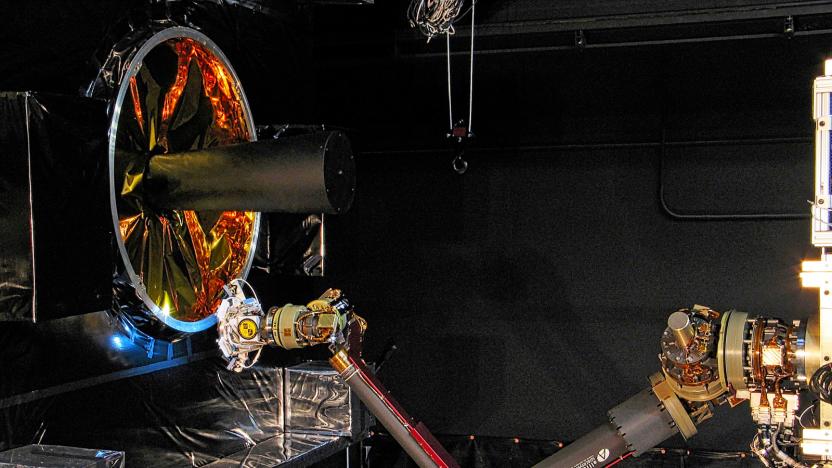NavalResearchLaboratory
Latest

Vanguard I has spent six decades in orbit, more than any other craft
As of this month, the US satellite Vanguard I has spent 60 years in orbit and it remains the oldest man-made object in space. Vanguard I was the fourth satellite launched into orbit -- following the USSR's Sputnik I and II and the US' Explorer I. But none of the first three remain in orbit today and though Vanguard I can't send signals back to Earth anymore, it's still providing valuable data for researchers.

The Navy built rechargeable batteries that won't explode on you
The Navy, the airline industry and Samsung all have a major problem with lithium-ion batteries. Specifically, they tend to catch fire more than most people would like. But that could change soon thanks to a new breakthrough from the US Naval Research Laboratory (NRL) that allows for safe, rechargeable nickel-zinc batteries with a similar performance to Li-ion cells, but without all the flames.

How the Navy's orbiting robots will refurbish civilian satellites
Geosynchronous orbits above Earth are among the most valuable real estate in the solar system. This band of space is utilized by everything from civilian communications and GPS satellites to government-operated weather and nuclear monitors to military applications like on-demand warfighter broadband. It's also a veritable minefield of broken-down, ground-up derelict satellites.

Scientists make a transistor from a single molecule
You're looking at what could be not just one of the smallest semiconductor parts ever, but one of the smallest semiconductor parts possible. A worldwide research team has built a transistor that consists of a single copper phthalocyanine molecule, a dozen indium atoms and an indium arsenide backing material. The trick was to abandon the usual mechanics of a transistor, which normally controls current by modulating the gate voltage, in favor of a field effect. Here, you only need to vary the distance of the gate (in this case, the atoms) to modulate electricity.

US Navy's cheap and tiny Cicada drones can listen in on the enemy
The Navy's Cicada drone has reemerged looking smaller than ever. Navy scientists have been developing the tiny smart glider since 2006 and even performed a flight test back in 2011. This newest iteration, which has been presented at the Department of Defense's "Lab Day" last week, is the smallest one yet and can fit in the palm of your hand. The US Navy has always envisioned the Cicada drone, formally named Covert Autonomous Disposable Aircraft -- a completely different project from the Navy's LOCUST drones -- to be tiny, low-cost and ultimately disposable. Like the insect, it was designed to fly in swarms and do its job until it (or, technically, its battery) dies. Despite looking like an innocuous paper/plastic plane, it's loaded with sensors -- Agence France-Presse even calls it a "phone with wings."

Duck-like US Navy drone can fly or swim to hunt submarines
There are plenty of flying and swimming drones, but you'd ideally have both at once for sub-hunting -- you want something that can poke its head underwater, but move quickly through the air when needed. The US Navy certainly knows this. It's developing a duck-like drone, the Flimmer, that can both fly and swim. In addition to both a rear-facing propeller and wings, its latest incarnation has four fins that adapt to what the robotic craft is doing. In flight, they serve as stabilizers and canard wings; in the sea, they flap to give the machine a speed boost.

US Navy's Ion Tiger drone leans on liquid hydrogen for longer-lasting spy flight
The US Navy's quieter way to spy, the Ion Tiger, just bested its own 2009 flight record with a key assist from liquid hydrogen. The unmanned aerial vehicle had previously relied on 5000-psi compressed hydrogen for fuel, but for its latest flight test the Naval Research team swapped that out for a new cryogenic tank and delivery system that relies on the liquid stuff; a choice made for the element's increased density. With that one significant change in place, the craft was able to outperform its last endurance run of 26 hours and two minutes by almost double, lasting 48 hours and one minute in a flight made mid-April. Spying: it's not only good for the government, it's good for the environment, too.

Naval researchers soak up the sun below sea level with special solar cells
Have you ever harbored delusions of living in an underwater city inhabited by the likes of Ariel or those aliens from The Abyss? Yeah, well keep dreaming, because this engineering feat won't necessarily lead to that (the fictional mer people part, that is). What it will pave the way for is a new means of harnessing the sun's rays below sea level to power submerged sensor systems and platforms. The research, carried out by a team of U.S. Naval scientists, forgoes traditional crystalline and amorphous silicon photovoltaic cells for those based on the more efficient gallium indium phosphide. The reason? Turns out those latter semiconductors are well-suited to absorbing photons in the blue / green spectrum -- precisely the wavelengths that diffused sunlight take on under water. Using this newer approach, the team's proven that about 7 watts of energy can be generated per square meter of these deployed cells at a depth of up to 9.1 meters (30 feet). Further refinements and testing are, naturally, on deck, but soon enough we may be looking at a whole new world of possibilities under the sea. [Image courtesy Flickr]

LASR: behind the curtain of the Navy's robotics laboratory
I don't know all that much about the Naval Research Laboratory when I arrive in DC for "the public's first opportunity to look inside" the space's new $17 million Laboratory for Autonomous Systems Research (LASR). I give the cab driver the address, and he casually tells me that it "stinks," illustrating this notion with a universally familiar hand gesture. He means it literally, too - that you can smell the place, simply driving by in a cab, with the windows up. He says this with such assurance, such gusto, that I fully expect it to smell like the city dump. A wall of stink. It's not much to go on, but it's something. And while I can thankfully report that his reaction was a bit overstated - at least on this particular day - there's certainly a distinct odor to the place. It's a sprawling 130-acre complex that sits sandwiched between the 295 freeway and the waters of the Potomac River; a series of nearly identical big, white buildings facing inward toward a grassy courtyard. On the way in, a space with what appears to be crushed cars is visible from the freeway.

US Navy shows off its new LASR autonomous robot testing facility
All the fun of the desert and the rainforest from the (relative) comfort of home? Sign us up. That's the promise offered by the admittedly awesomely named Laboratory for Autonomous Systems Research (that's LASR, for you abbreviators out there), first announced last month. The robotics lab, housed in a $17.7 million building at the Naval Research Laboratory in Washington DC, offers up around 50,000 square feet, a portion of which is aimed at reproducing some of the Earth's more extreme ecosystems to test out naval robotics. The facility is home to firefighting robots, swimming 'bots and hydrogen fuel cell-powered unmanned aircrafts, to name but a few. The Naval Research Laboratory opened the doors of the massive facility up to members of the media today, and Engadget was on-hand along with a moderate sized gathering of fellow reporters. Included in the tour were two simulated environments. The Tropical High Bay is designed to mimic rainforest terrain, with flowing water, fog and climate controlled temperature and humidity. The Desert High Bay is a bit let complex in its environmental simulation, limited to a sand pit, rock way, and adjustable light, smoke and wind. Meanwhile, an on-site indoor pool is used to challenge aquatic vehicles. Testers demonstrated the Pectoral Fin Swimmer – an autonomous bot inspired by the biological movements of fish, in order to access areas not reached by more traditional propel driven robots. Also on hand was Lucas, a Mobile, Dexterous, Social (MDS) humanoid robot [pictured above] with a Segway base. The laboratory demonstrated how the robot was capable of reasoning in a simulated firefighting scenario – and, equipped with an extinguisher, was capable of putting out a very real fire on the floor of the facility. We'll have a more in-depth tour of the facility in the near future. In the meantime, check out a sneak-peek of what we saw in the gallery below.

SAFFiR: the autonomous, firefighting humanoid robot
It took six years, but at long last, Anna Konda has a formidable firefighting partner. SAFFiR, also known as the Shipboard Autonomous Firefighting Robot, is being shaped by scientists at the Naval Research Laboratory. As the story goes, it's a humanoid robot that's being engineered to "move autonomously throughout the ship, interact with people, and fight fires, handling many of the dangerous firefighting tasks that are normally performed by humans." Outside of being stoic (and brawny) from tip to tip, it's also outfitted with multi-modal sensor technology for advanced navigation and a sensor suite that includes a camera, gas sensor, and stereo IR camera to enable it to see through smoke. We're told that its internal batteries can keep it cranking for a solid half-hour, while being capable of manipulating fire suppressors and throwing propelled extinguishing agent technology (PEAT) grenades. Wilder still, it'll be able to balance in "sea conditions," making it perfect for killing flames while onboard a ship. Of course, it's also being tweaked to work with a robotic team, giving it undercover powers to eventually turn the flames on the folks that created it. Paranoid? Maybe. But who are we to be too careful?Update: Turns out, the same Dr. Hong that we had on The Engadget Show is responsible for this guy as well. It's the next step in evolution of the CHARLI humanoid, and the two photos seen after the break are credited to RoMeLa: Robotics & Mechanisms Laboratory, Virginia Tech.

Navy tests bacteria-powered hydrogen fuel cell, could start monitoring your underwater fight club
Microbial fuel cells aren't exactly new, but microbial fuel cells scouring the ocean floor? Now that's an initiative we can get behind. The Naval Research Laboratory is currently toying around with a so-called Zero Power Ballast Control off the coast of Thailand, presumably looking for treasures dropped from the speedboat of one "Alan Garner." Purportedly, the newfangled hydrogen fuel cell relies on bacteria to provide variable buoyancy, which allows an autonomous ocean sensor to move up and down water columns with little to no effort. Furthermore, it's able to get its energy from microbial metabolism (yeah, we're talking about hot air), and while it's mostly being used to measure things like temperature and pressure, it could be repurposed for more seirous tasks -- like mine detection. There's no clear word yet on when America's Navy will have access to this stuff, but if we had to guess, they've probably be using it behind our backs for the better part of a score. [Image courtesy of U.S. Navy Reserve / Tom Boyd]

Researchers use magnetic fields to manipulate light
We've seen magnetics used in everything from closet improvements to insomnia treatments, but researchers at the University of Alberta and the United States Naval Research Laboratory have found that "by manipulating electron spin using magnetic fields, they can turn off and on light that's being guided through metals." By looking deeper into the fields of plasmonics and spintronics, the gurus have discovered that this on-off light switch could be used for tasks such as routing infrared light in optical communications or processing radio signals in cell phones. Additionally, this system could potentially decrease power requirements for the devices it invades, and while a finalized product isn't quite ready, the team is already anxious to "build devices that can act as switches in a chip."






